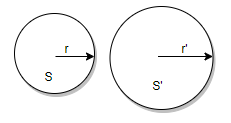
Twenty-seven solid iron spheres, each of radius r and surface area S are melted to form a sphere with surface area ${{S}^{'}}$. Find the
(i) radius ${{r}^{'}}$ of the new sphere
(ii) ratio of S and ${{S}^{'}}$.
Answer
560.7k+ views
Hint: We first express the surface area and the volume formula for spheres. We find the total volume of those 27 smaller spheres together which is equal to the volume of the bigger sphere. From that relation we find the radius of the new sphere and the ratio of S and ${{S}^{'}}$.
Complete step by step answer:

We know that the formula of surface area for a solid sphere with radius r is $4\pi {{r}^{2}}$ square unit.
For our given problem there are twenty-seven solid iron spheres, each of radius r and surface area S. So, $S=4\pi {{r}^{2}}$. Let the volume of 1 sphere be v, then from the formula of volume we can say that $v=\dfrac{4}{3}\pi {{r}^{3}}$.
All these small spheres have been melted into a bigger sphere. So, the total volume of those 27 smaller spheres together is equal to the volume of the bigger sphere.
Let’s assume that the radius, surface area and the volume of the new sphere is ${{r}^{'}},{{S}^{'}},{{v}^{'}}$ respectively.
We first calculate the total volume of those 27 smaller spheres, each having volume $v=\dfrac{4}{3}\pi {{r}^{3}}$.
So, 27 spheres will have total volume of $27v=27\times \dfrac{4}{3}\pi {{r}^{3}}=36\pi {{r}^{3}}$.
Now we know that $27v=36\pi {{r}^{3}}={{v}^{'}}..........(i)$.
According to the radius of the new sphere ${{r}^{'}}$, the volume of the bigger sphere will be ${{v}^{'}}=\dfrac{4}{3}\pi {{\left( {{r}^{'}} \right)}^{3}}........(ii)$
From equation (i) and equation (ii) we get ${{v}^{'}}=\dfrac{4}{3}\pi {{\left( {{r}^{'}} \right)}^{3}}=36\pi {{r}^{3}}$.
Now we express ${{r}^{'}}$ with respect to $r$.
$\begin{align}
& \dfrac{4}{3}\pi {{\left( {{r}^{'}} \right)}^{3}}=36\pi {{r}^{3}} \\
& \Rightarrow {{\left( {{r}^{'}} \right)}^{3}}=27{{r}^{3}}={{\left( 3r \right)}^{3}} \\
& \Rightarrow {{r}^{'}}=3r \\
\end{align}$
So, the radius of the new sphere is thrice to the previous spheres.
The surface area of new sphere will be ${{S}^{'}}=4\pi {{\left( {{r}^{'}} \right)}^{2}}=4\pi {{\left( 3r \right)}^{2}}=36\pi {{r}^{2}}$.
We need to find the ratio of S and ${{S}^{'}}$.
So, $\dfrac{S}{{{S}^{'}}}=\dfrac{4\pi {{r}^{2}}}{36\pi {{r}^{2}}}=\dfrac{1}{9}$. The ratio is $1:9$.
Note: We can see that the surface area ratio is equal to the square of ratio of the radii and the volume ratio is equal to the cube of ratio of the radii. They are directly proportional. To find the connection between bigger and smaller spheres the spheres have to be solid, otherwise we wouldn’t have got the volume.
Complete step by step answer:

We know that the formula of surface area for a solid sphere with radius r is $4\pi {{r}^{2}}$ square unit.
For our given problem there are twenty-seven solid iron spheres, each of radius r and surface area S. So, $S=4\pi {{r}^{2}}$. Let the volume of 1 sphere be v, then from the formula of volume we can say that $v=\dfrac{4}{3}\pi {{r}^{3}}$.
All these small spheres have been melted into a bigger sphere. So, the total volume of those 27 smaller spheres together is equal to the volume of the bigger sphere.
Let’s assume that the radius, surface area and the volume of the new sphere is ${{r}^{'}},{{S}^{'}},{{v}^{'}}$ respectively.
We first calculate the total volume of those 27 smaller spheres, each having volume $v=\dfrac{4}{3}\pi {{r}^{3}}$.
So, 27 spheres will have total volume of $27v=27\times \dfrac{4}{3}\pi {{r}^{3}}=36\pi {{r}^{3}}$.
Now we know that $27v=36\pi {{r}^{3}}={{v}^{'}}..........(i)$.
According to the radius of the new sphere ${{r}^{'}}$, the volume of the bigger sphere will be ${{v}^{'}}=\dfrac{4}{3}\pi {{\left( {{r}^{'}} \right)}^{3}}........(ii)$
From equation (i) and equation (ii) we get ${{v}^{'}}=\dfrac{4}{3}\pi {{\left( {{r}^{'}} \right)}^{3}}=36\pi {{r}^{3}}$.
Now we express ${{r}^{'}}$ with respect to $r$.
$\begin{align}
& \dfrac{4}{3}\pi {{\left( {{r}^{'}} \right)}^{3}}=36\pi {{r}^{3}} \\
& \Rightarrow {{\left( {{r}^{'}} \right)}^{3}}=27{{r}^{3}}={{\left( 3r \right)}^{3}} \\
& \Rightarrow {{r}^{'}}=3r \\
\end{align}$
So, the radius of the new sphere is thrice to the previous spheres.
The surface area of new sphere will be ${{S}^{'}}=4\pi {{\left( {{r}^{'}} \right)}^{2}}=4\pi {{\left( 3r \right)}^{2}}=36\pi {{r}^{2}}$.
We need to find the ratio of S and ${{S}^{'}}$.
So, $\dfrac{S}{{{S}^{'}}}=\dfrac{4\pi {{r}^{2}}}{36\pi {{r}^{2}}}=\dfrac{1}{9}$. The ratio is $1:9$.
Note: We can see that the surface area ratio is equal to the square of ratio of the radii and the volume ratio is equal to the cube of ratio of the radii. They are directly proportional. To find the connection between bigger and smaller spheres the spheres have to be solid, otherwise we wouldn’t have got the volume.
Recently Updated Pages
Master Class 10 General Knowledge: Engaging Questions & Answers for Success

Master Class 10 Science: Engaging Questions & Answers for Success

Master Class 10 Social Science: Engaging Questions & Answers for Success

Master Class 10 Maths: Engaging Questions & Answers for Success

Master Class 10 English: Engaging Questions & Answers for Success

Master Class 10 Computer Science: Engaging Questions & Answers for Success

Trending doubts
The shortest day of the year in India

Why is there a time difference of about 5 hours between class 10 social science CBSE

Write a letter to the principal requesting him to grant class 10 english CBSE

What is the median of the first 10 natural numbers class 10 maths CBSE

The Equation xxx + 2 is Satisfied when x is Equal to Class 10 Maths

State and prove converse of BPT Basic Proportionality class 10 maths CBSE




